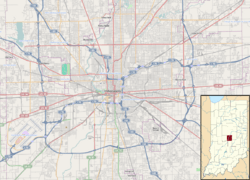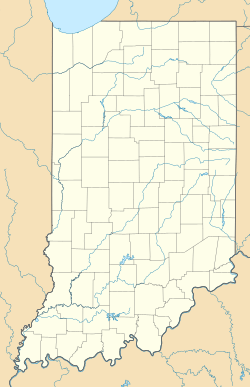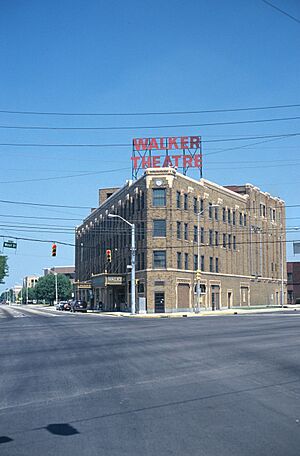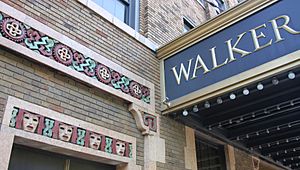Madam Walker Legacy Center facts for kids
|
Madam C. J. Walker Manufacturing Company
|
|
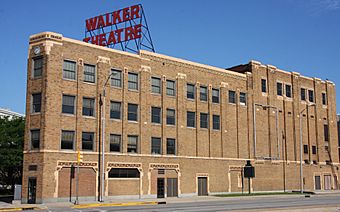
The building in 2016
|
|
| Location | Indianapolis, Indiana |
|---|---|
| Built | 1927 |
| Architect | Rubush & Hunter |
| Architectural style | African-Art Deco |
| NRHP reference No. | 80000062 |
Quick facts for kids Significant dates |
|
| Added to NRHP | July 17, 1980 |
| Designated NHL | July 17, 1991 |
The Madam C. J. Walker Building, also known as the Madam Walker Legacy Center, is a special building in Indianapolis, Indiana. It was built in 1927. This building is named after Madam C. J. Walker, a famous African American businesswoman. She created hair care and beauty products.
The building was once the main office for Madam Walker's company. It was also a busy place for the city's African American community. People gathered there for fun, business, and cultural events. The building has unique designs from Africa, Egypt, and Moorish styles. It is one of the few buildings in the United States with this African-Art Deco look. The Madam C. J. Walker Building was recognized as a National Historic Landmark in 1991. It was also added to the National Register of Historic Places in 1980.
Contents
Building History and Purpose
Madam C.J. (Sarah Breedlove) Walker (1867–1919) started planning this building before she passed away in 1919. Her daughter, A'Lelia Walker, and the company's attorney, Freeman B. Ransom, finished the project. The building was named to honor Madam Walker. It opened on December 26, 1927, eight years after her death. The Indianapolis company Rubush & Hunter designed the four-story building.
The Walker Building is on Indiana Avenue. This area was a lively spot for the city's African American community from the 1920s to the 1950s. The building served as the main office for the Madam C. J. Walker Manufacturing Company. This company was one of the first and most successful Black-owned businesses in the U.S. In 1910, Madam Walker moved her company's main office to Indianapolis. At one point, her factory there employed about 3,000 women.
When the new building opened in 1927, it had many uses. It housed the company's offices and factory. It also included a beauty school and salon. There was a large ballroom called the Grand Casino. The building also had a movie theater, a drugstore, a restaurant, and other offices.
The Walker Theater Company managed the theater space. It showed movies and live shows. Many famous jazz musicians played there, like Wes Montgomery and Freddie Hubbard. The theater also hosted vaudeville acts. In the mid-1950s, the building and its neighborhood started to decline. The theater even closed for a short time in the 1960s.
Saving the Building
By the late 1970s, the Walker Building was almost empty. It was in danger of being torn down. But a group of people in Indianapolis saw its important history. They started a project to save the old building. The theater was closed from around 1978 or 1979 until it was fixed up and reopened in 1988.
A group called the Madam Walker Building Urban Life Center formed in 1979. They bought the building from the Walker Manufacturing Company. Their goal was to make it a cultural center again. The building was listed on the Indiana Register of Historic Sites and Structures in 1980. It was also added to the National Register of Historic Places that same year. In 1982, the group changed its name to the Madam Walker Urban Life Center.
The first part of the restoration finished in 1983. This included offices and the Grand Casino Ballroom. Money was raised to restore the Walker Theatre, which now seats 935 people. The theater's design shows African art, just as A'Lelia Walker had planned. Organizations like Lilly Endowment helped pay for the restoration. In October 1988, the Walker Theatre reopened. The Madam Walker Urban Life Center managed the fully restored building.
The building was named a National Historic Landmark on July 17, 1991. In 1996, the Madam Walker Urban Life Center changed its name again. It became the Madam Walker Theatre Center. This new name better showed what the group did.
In 2018, Indiana University and Indiana University – Purdue University Indianapolis partnered with the Madam Walker Theatre Center. They wanted to keep preserving and restoring the building. A large grant from the Lilly Endowment helped pay for these renovations. The building was also renamed the Madam Walker Legacy Center.
Programs and Events
Since it opened in 1927, the Walker Building has been a place for community events. It hosts many arts and cultural programs. In 1987, the Madam Walker Theatre Center started the Youth-in-Arts program. This program helped young people experience the arts. The theater's education program was updated in 2007.
Other Uses of the Center
The center also provides space for other groups, like Freetown Village and Iibada Dance Company. It can be rented by other arts, social, and business groups. They use the facilities for their own programs and activities.
The theater is used for many different events. These include pageants, musicals, concerts, and lectures. It also hosts auditions, rehearsals, movie screenings, and award ceremonies.
Building Design and Features
The building's decorations are inspired by African art. Many of these designs are mixed with Art Deco geometric shapes. Some people say the Walker Theatre is one of the few African-Art Deco buildings left in the United States.
A'Lelia Walker asked the company Rubush & Hunter to design the building in 1927. It cost $350,000 to build. The building is on a triangular piece of land in Indianapolis. It included a theater, a ballroom, and the Walker Company's factory and offices. There was also a beauty school, a drugstore, a restaurant, and rental offices.
Outside the Building
The four-story building is made of concrete and yellow brick. It has an asphalt roof. The building has two main sides facing Indiana Avenue and West Street. The Indiana Avenue side has storefronts and the theater entrance. The West Street side has a stage entrance and emergency exits. There is another entrance at the point where Indiana Avenue and West Street meet.
The building has decorative details made of Terracotta around its ground-level openings. These decorations include designs from Africa, Moorish culture, and Egypt. They also feature geometric lines typical of Art Deco.
The upper parts of the building have many windows. The theater's marquee and box office also show Moorish designs. The back of the building is taller than the other sides. This is to fit the theater's stage equipment.
Inside the Building
The inside of the building has bright colors. It features Egyptian and Moorish designs with Art Deco details on the walls and ceilings. The theater is the largest part of the building. It can seat 935 people today. The theater has a big stage with a grand drape. It also has an orchestra pit and fancy decorations.
The stage is guarded by two Egyptian-inspired sphinxes. The stage walls and ceiling have many designs. These include African masks, warrior shields, spears, animals, and other unique symbols. The theater also has brass decorations. Other features include lighting and sound systems, dressing rooms, and a bar lounge.
Besides the theater, the building has other event spaces. These include the Grand Casino Ballroom and the A'Lelia Bundles Conference Center. The stage and the ballroom have been redecorated over the years.
Lasting Importance
The Walker Building was added to the National Register of Historic Places in 1980. It was named a National Historic Landmark in 1991.
This historic building is still an important place on Indiana Avenue. It was once the main office and factory for the Walker Company. It also provided many jobs for Black women. From the 1920s to the 1950s, it was a central place for the African American community. The restored building continues to honor Madam C.J. Walker's success. It also shows her interest in supporting the arts.
The Walker Building is the only building left from Indiana Avenue's once lively nightlife. Since 1927, it has offered performances and educational programs. It is also a place for public and private gatherings. As of 2012, it was one of the few National Historic Landmarks owned and run by African Americans in the city. The building's goal is to promote social justice and cultural education. It also aims to help "the next generation of entrepreneurs" and leaders. It stands as a "symbol of African-American pride."
In Pop Culture
The historic Walker Theatre is mentioned in the song "Naptown Blues" by Leroy Carr. It is also in the poem "I Am A Black Woman" by Mari Evans.
See also


